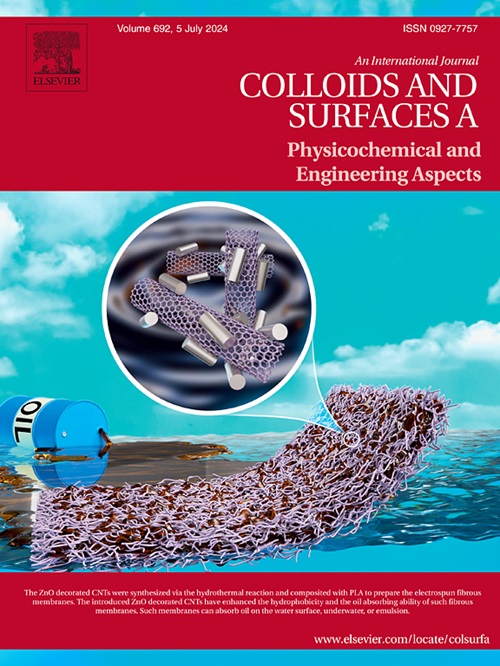用于低温白云岩地热储层激发的缓发泡酸液体系及其作用机理
IF 4.9
2区 化学
Q2 CHEMISTRY, PHYSICAL
Colloids and Surfaces A: Physicochemical and Engineering Aspects
Pub Date : 2024-11-05
DOI:10.1016/j.colsurfa.2024.135717
引用次数: 0
摘要
酸化是通过向储层注入酸性流体来溶解岩石以增加地层渗透性,从而提高地热储层的生产率。然而,传统的酸性流体要么无法实现有效酸化,要么会对地热储层造成破坏。泡沫酸液已被应用于油气储层的激发,它可以通过延缓酸-岩反应实现有效酸化,并能保护储层。本文提出了一种泡沫酸液系统,旨在实现低温白云岩地热储层的高效酸化和储层保护。使用甲酸(FA)和乙酸(HAc)替代部分盐酸(HCl)。添加烷基甘氨酸表面活性剂 AGS-12 用于发泡,黄原胶和纳米二氧化硅颗粒用于稳定泡沫。添加缓蚀剂和铁离子稳定剂是为了抑制钢的酸腐蚀和铁离子沉淀。通过泡沫稳定性、溶解性能、缓蚀性能和兼容性来评估酸化效果。应用显微观察、场发射扫描电子显微镜和数值模拟揭示了泡沫和酸溶解行为的时间演变机制。结果表明,含 5 wt% FA、5 wt% HAc 和 10 wt% HCl 酸的泡沫酸液具有最佳的泡沫稳定性和缓蚀效果。与非泡沫酸性液体相比,泡沫酸性液体的切屑质量变化率降低幅度超过 50%,泡沫主要减缓酸-岩反应。模拟结果与实验结果一致,表明切屑在 FA 和 HAc 中的溶解度较低。在含FA和HAc的泡沫酸液中进行酸岩反应后,岩屑表面的钙(Ca)含量低于在仅含盐酸的泡沫酸液中进行酸岩反应后的钙含量,这表明FA和HAc能抑制含钙矿物沉淀,因为甲酸根离子和醋酸根离子能与Ca2+发生螯合作用。由于弱酸部分解离产生的氢离子减少,FA 和 HAc 取代盐酸有助于降低泡沫酸液的腐蚀性和兼容性。这项研究表明,在地热储层刺激过程中使用泡沫酸流体是可行的,而且不会对储层造成损害。本文章由计算机程序翻译,如有差异,请以英文原文为准。
A retarded foam acid fluid system for low-temperature dolomite geothermal reservoir stimulation and its action mechanisms
Acidizing improves geothermal reservoir productivity by dissolving rocks to increase formation permeability, which is achieved by injecting acid fluids into reservoir formations. However, conventional acid fluids either can not achieve effective acidizing or cause geothermal reservoir damages. Foam acid fluids, which have been applied for oil-gas reservoir stimulation, can realize effective acidizing by retarding acid-rock reactions, and can protect reservoirs. Here, a foam acid fluid system is proposed, aiming at achieving efficient acidizing and reservoir protection in low-temperature dolomite geothermal reservoirs. Formic acid (FA) and acetic acid (HAc) are used to replace a portion of hydrochloride (HCl) acid. Alkyl glycine surfactant AGS-12 is added for foaming, while xanthan gum and nano silica particles are used to stabilize foams. Corrosion inhibitor and ferric ion stabilizer are added to inhibit acid corrosion of steel and ferric ion precipitations. The acidizing effect was evaluated through foam stability, dissolution performance, corrosion inhibition performance, and compatibility. Microscopic observation, field emission scanning electron microscope, and numerical simulation were applied to reveal the mechanisms of temporal evolution of foams and acid dissolution behaviors. Results show that the foam acid fluid with 5 wt% FA, 5 wt% HAc and 10 wt% HCl acid has the best foam stability and retardation effect. Compared to non-foam acid fluid, the decrease degree of the cuttings mass change rate in foam acid fluids exceeds 50 %, and foaming primarily retards acid-rock reactions. Simulation results is consistent with the experiment results, demonstrating that the cuttings dissolve less in FA and HAc. Calcium (Ca) content on the cuttings surfaces after acid-rock reactions in foam acid fluids with FA and HAc is less than that after acid-rock reactions in foam acid fluid with sole HCl acid, indicating that FA and HAc inhibit Ca-bearing mineral precipitations, as formate and acetate ions can chelate with Ca2+. The replacement of HCl acid by FA and HAc contributes to a low corrosivity and good compatibility of the foam acid fluids due to a reduced hydrogen ions resulted from partial dissociation of weak acids. This study shows the feasibility of foam acid fluids during geothermal reservoir stimulation with eliminated reservoir damages.
求助全文
通过发布文献求助,成功后即可免费获取论文全文。
去求助
来源期刊
CiteScore
8.70
自引率
9.60%
发文量
2421
审稿时长
56 days
期刊介绍:
Colloids and Surfaces A: Physicochemical and Engineering Aspects is an international journal devoted to the science underlying applications of colloids and interfacial phenomena.
The journal aims at publishing high quality research papers featuring new materials or new insights into the role of colloid and interface science in (for example) food, energy, minerals processing, pharmaceuticals or the environment.

 求助内容:
求助内容: 应助结果提醒方式:
应助结果提醒方式:


